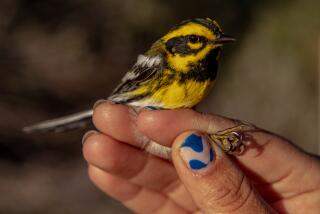Sex and the Single Canary Conundrum
- Share via
You may have read our obituary of Dr. Ralph W. Schreiber a week or two ago. Dr. Schreiber was county ornithologist, or curator of birds at the Museum of Natural History. He died at 45 of cancer.
He was internationally respected among ornithologists for his contributions to our knowledge of birds and to their welfare. He was among those scientists and naturalists who discovered that the brown pelican was endangered by DDT, and who brought about the ban of the pesticide and saved that bird from extinction.
The brown pelican, of course, is the bird immortalized by Dixon Lanier Merritt in his limerick:
A wonderful bird is the pelican,
His bill will hold more than his belican....
Despite his international involvement with bird life, Dr. Schreiber found time to relate to the lowliest local bird watchers, even myself. We corresponded often over the years, and while we had our disagreements, as honest men will, he often verified some sighting or opinion of mine.
I believe Dr. Schreiber was not yet on the scene when I made my historic sighting of a grackle in my back yard (the bird had never before been seen west of the Mississippi), so he was not involved in the resulting controversy; however, I have in my files a note he sent me after I reported seeing the rather rare Stellar’s jay in the same back yard.
“I believe it,” Dr. Schreiber said unequivocally. “Have talked with several ‘hard-core’ birders in Los Angeles in the last day or so and they all agree that this would be a very good sighting for your neck of the woods, meaning that it is unusual, but entirely possible. All also agreed that you probably could in fact identify this jay. . . .”
I did suspect an implication in that last phrase that the Stellar’s jay is so distinctive in appearance that even I might correctly identify one; but nevertheless I was vindicated, and I took Dr. Schreiber’s verification as verification also of my sighting of the grackle and the extremely rare Lichtenstein’s oriole (first one seen in California).
Dr. Schreiber was also gracious and expert in his response when I asked him how to tell a female parakeet from a male parakeet. A colleague of mine at the office said he had to know.
I called Dr. Schreiber and asked him the question. “Let me call you back,” he said. He called back. “All right, here it is. What we call a parakeet is not, in common usage, a parakeet. It’s a budgerigar. The scientific name is really pretty--it’s melo psittacus undulatus .
In breeding season, he went on, the fleshy spot at the base of the beak, called the cere, is dark blue in the male, brown in the female. But because there are numerous species, and much random breeding for color, this test is not reliable. He said there were two other ways by which even an unskilled observer could readily tell the difference.
One of these ways, he said, was to watch them making love and see which one was on top. In parakeets, that would be the male. The other way was to see which one laid an egg. That would be the female. Of course, if you happened to have two males, you could watch and watch and never really know.
On one point, I regret to say, Dr. Schreiber and I never saw eye to eye. I have often referred to the scrub jays in our back yard as blue jays, my reasoning being that they are blue and that they are jays; thus, they are blue jays.
Noting once that a caption in our paper had identified a scrub jay in the yard of one Don Dinon of Bel-Air as a “blue jay,” Dr. Schreiber wrote to me, evidently unaware my own conviction on the point, and noted that The Times had a resident ornithologist on its staff, “even though he attempts to deny it.” He obviously meant me.
“I thus suggest you correct the misconception that Mr. Dinon has attracted ‘blue jays’ to his feeder--something that would cause a true ‘rare-bird alert’ in the state. I further suggest that the birds were in fact scrub jays ( Aphelocoma corulescens ) the common ‘blue-colored jay’ of the suburbs of California. You will be doing ornithology and the bird watchers a real service.”
Now Dr. Schreiber is gone. We all will miss him. And the least I can do for his memory is to concede, at last, that our blue jays indeed are scrub jays.
Rest in peace.
More to Read
Sign up for Essential California
The most important California stories and recommendations in your inbox every morning.
You may occasionally receive promotional content from the Los Angeles Times.








